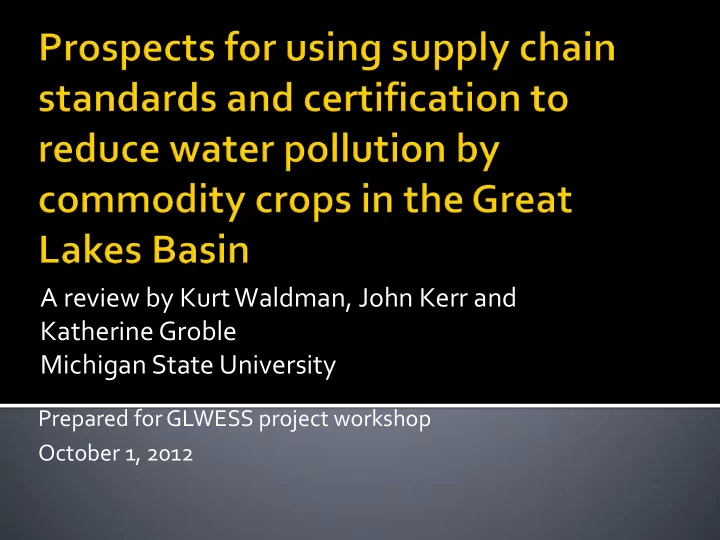

A review by Kurt Waldman, John Kerr and Katherine Groble Michigan State University Prepared for GLWESS project workshop October 1, 2012
Mandatory for suppliers Profit-driven, mainly for food safety They raise producer costs and limit market access to those who can comply They succeed when large buyers can enforce them or when they become the industry standard.
Operates outside the supply chain Rewards favorable practices with the aim that consumers will pay extra Labels act as signals to consumers Tends to cover small parts of the market
Consumer well-being (food safety) Animal welfare Producer well-being (fair trade and worker protection) Environmental protection
Inside (business to business) Mostly food safety Labor standards (e.g. Nike) Animal welfare (McDonald’s) Outside (Certification for consumers) Mostly environmental conservation and fair trade Public pressure to encourage better business standards like Nike and McDonald’s
Food safety standards REQUIRED for ALL PRODUCERS that supply large retailers Animal welfare standards are REQUIRED for ALL PRODUCERS that supply McDonald’s Business-to-consumer certification schemes cover tiny percentage of market
Core values: they care about these things per se Also various sources of business risk
Input risk Reputation risk Regulatory risk
If environmental degradation threatens supply of vital inputs
Publicity about bad behavior or bad outcomes for consumers Officials link Chi-Chi's hepatitis outbreak to green onions
Pre-emptive steps to maintain a good reputation
Government regulation could be worse than standards that industry might self- impose
Input risk Reputation risk Regulatory risk
How the product is consumed How the product is produced Nature of the supply chain
Will this increase the likelihood that consumers impose pressure?
Are conservation practices costly? Are they visible? Do all farms contribute equally to the problem?
Growers Growers Local grain elevators Processors Millers/grinders Corn Other oil uses Processors Corn Etha- Corn Bio- meal nol syrup plas- Other Retailers tics Retailers Retailers Retailers Retailers Retailers Retailers
Aggregation is the norm for grains Segregation raises costs. Is segregation necessary?
Outcome-based Often a small number of farms contribute most of the problem Non- polluting farms needn’t adopt costly practices Low transaction costs Need ways to identify main pollution sources and also identify adopters of conservation practices Continuous improvement Representation and fairness Universal
What are the best options for encouraging industry to agree to production standards that limit pollution of Great Lakes waters? What are the most effective ways to generate interest by consumers in demanding such standards? What approaches can minimize costs?
Recommend
More recommend